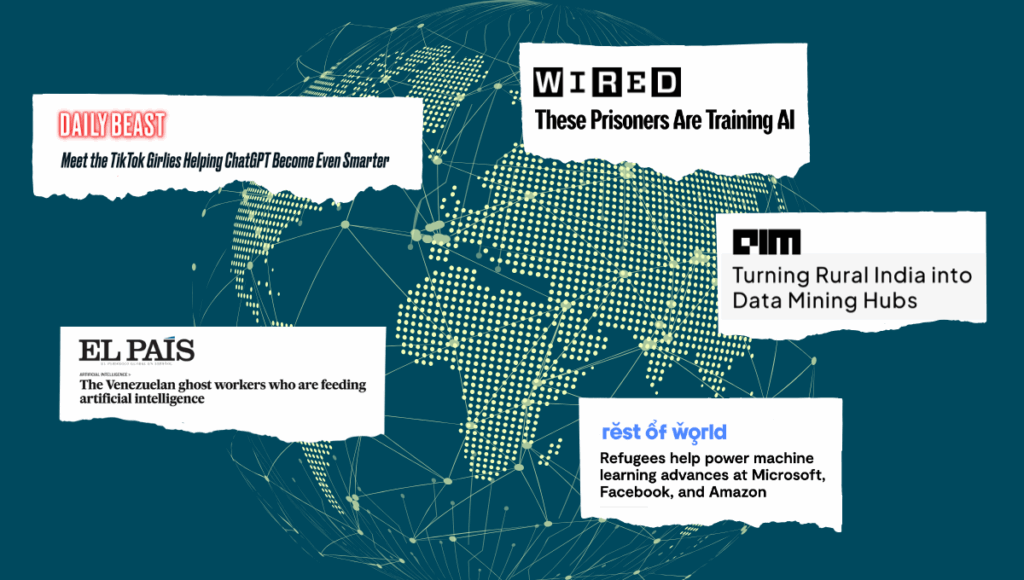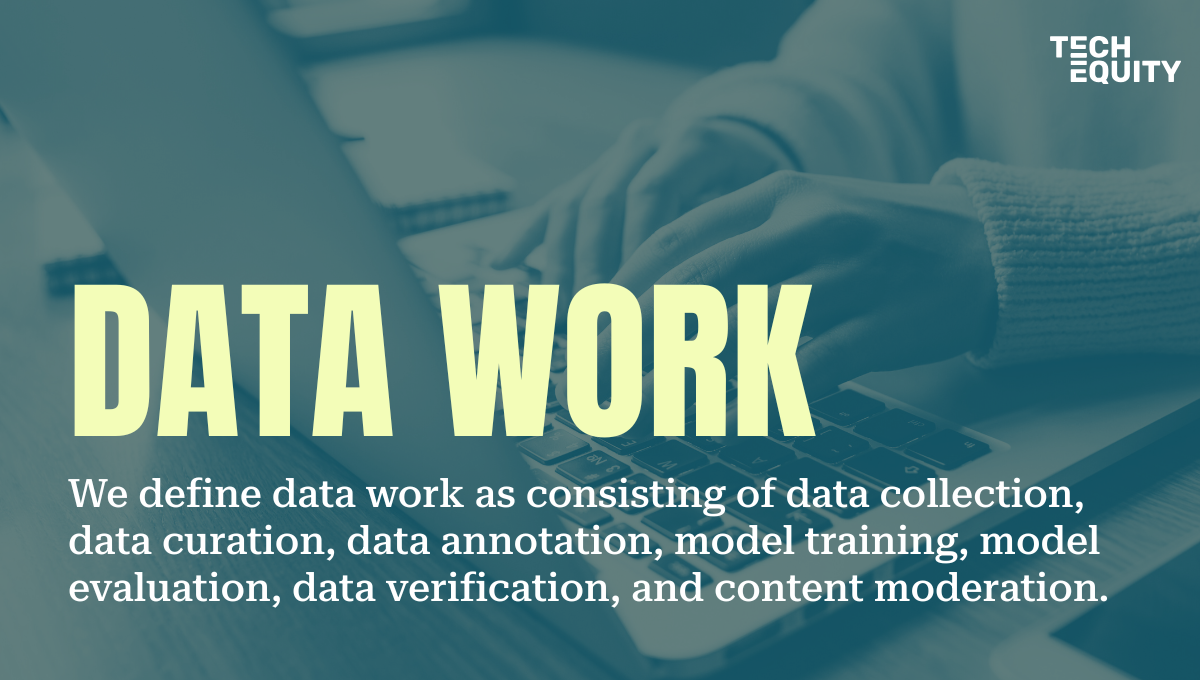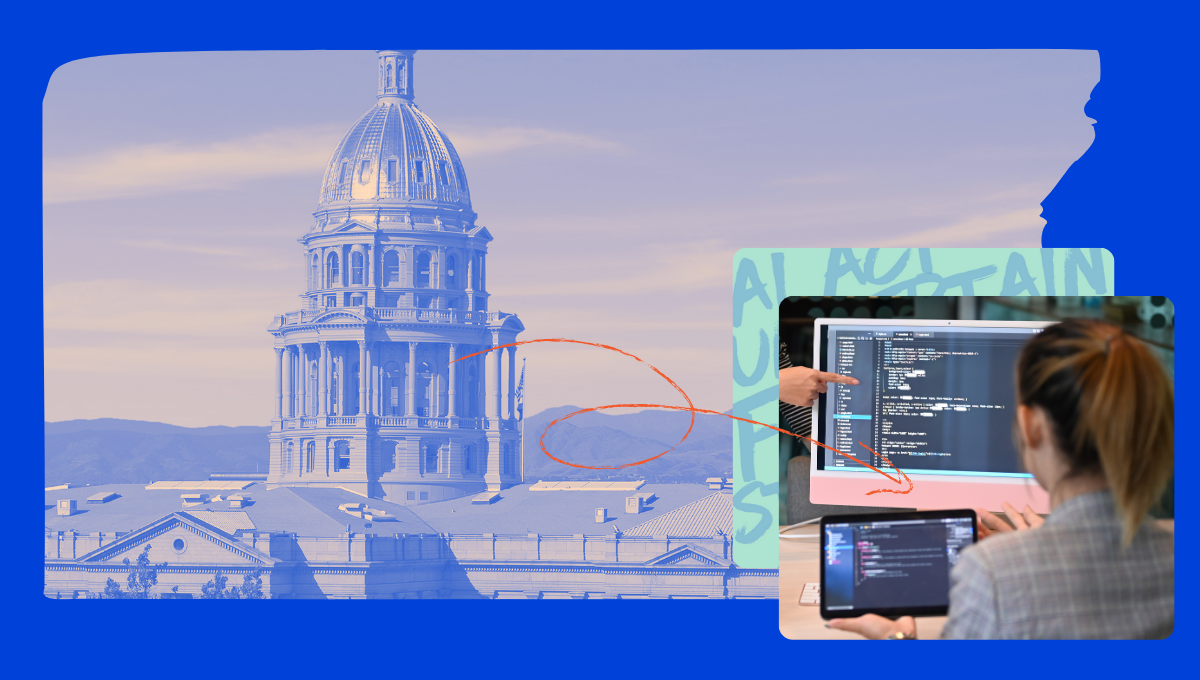Who’s powering AI? Shining a light on the AI data work industry.

AI tools have entered almost all aspects of our daily lives—from ordering groceries to writing emails, and even picking presents for and checking in on friends and family. While there is a dawning realization that our data fuels these tools, few are aware of the thousands of data workers in the US and around the world who build and maintain AI.
Who are data workers?

Between the frontend of AI applications that we see on our phones and computers and the backend of coders and engineers who program large language models (LLMs), there are long chains of workers who generate and annotate the data that feeds AI systems, train and test these systems, and even fill-in for them when they fail to perform as intended.

These data workers work for companies in an industry that is highly fragmented and opaque. Starting from Big Tech companies in Silicon Valley and elsewhere, chains of subcontracting relationships stretch across the world. Global subcontracting has long been a common business strategy for companies trying to increase margins by cutting labor and compliance costs by outsourcing work domestically or offshoring work to countries with poorly enforced labor laws. Companies and workers who contribute different knowledge and resources to AI systems are also part of a global value chain in which they co-create these powerful tools.
Workers themselves often don’t know to which AI systems or tools they’re contributing. Data work tends to be low-wage and precarious, and workers report mental health impacts from certain aspects of this work. Data workers struggle to make ends meet even as companies raise billions of dollars in private equity and venture capital.
Pulling back the curtain
For workers and their advocates to improve data work, the first challenge is understanding which companies operate in this space, what they do, and how they are related to each other. The current lack of transparency across the industry makes it difficult to understand where power and influence lies among different companies in the AI value chain and how those companies influence working conditions. The global and fragmented nature of the work, which takes place both in physical offices and on platforms in workers’ homes, and the constant shifting of companies’ contracts, also poses a challenge for workers and organizations seeking to find workers to be able to bring them together to fight for improved conditions.
We created the Data Work Landscape to help address this challenge. By highlighting some of the companies that employ data workers, we can begin to throw light on this shadowy industry—and provide a resource to workers building power in this industry.
Delve into more resources
The landscape provides a snapshot of some of the companies that employ data workers, but this resource is not – and cannot be – complete. This project is one among many that are unveiling the data work industry and the workers who power it. Researchers, workers, and advocates worldwide are filling in the gaps collectively, and this work wouldn’t be possible without everyone’s contributions. If you would like to learn more about the global data work portion of the AI value chain, along with how labor contributes in many ways to the creation of digital technologies, here are additional resources that have informed the TechEquity team’s understanding of these issues:
- Equidem. Scroll. Click. Suffer: The Hidden Human Cost of Content Moderation and Data Labelling. May 29, 2025.
- Milagros Miceli, Paola Tubaro, Antonio A. Casilli, Thomas Le Bonniec, Camilla Salim Wagner, et al.. Who Trains the Data for European Artificial Intelligence?. European Parliament; The Left. 2024, pp.1-40.
- Blair Attard-Frost and David Gray Widder. The Ethics of AI Value Chains. September 18, 2024.
- David Gray Widder, Richmond Wong. Thinking Upstream: Ethics and Policy Opportunities in AI Supply Chains. April 16, 2024.
- James Muldoon, Callum Cant, Boxi Wu, and Mark Graham. A typology of artificial intelligence data work. Big Data & Society Volume 11, Issue 1. March 18, 2024.
- Asmita Bhutani. Women Workers Behind the AI Revolution: The Production and Reproduction of Data Annotation Platforms. University of Toronto. November 2023.
- Morgan, R. A., van Zoonen, W., & ter Hoeven, C. (2023). Lost in the crowd? An investigation into where microwork is conducted and classifying worker types. European Journal of Industrial Relations, 29(3), 301-322. (Original work published April 28, 2023)
- Le Ludec, C., Cornet, M., & Casilli, A. A. (2023). The problem with annotation. Human labour and outsourcing between France and Madagascar. Big Data & Society, 10(2). (Original work published July 25, 2023)
- Bidisha Chaudhuri and Srravya Chandhiramowuli. Match Made by Humans: A Critical Enquiry into Human-Machine Configurations in Data Labelling. Proceedings of the 56th Hawaii International Conference on System Sciences. January 3, 2023.
- Julian Posada. The Coloniality of Data Work: Power and Inequality in Outsourced Data Production for Machine Learning. University of Toronto. 2022.
- Ahmad, S., & Greb, M. (2022). Automating social media content moderation: implications for governance and labour discretion. Work in the Global Economy, 2(2), 176-198. October 27, 2022.
- Milagros Miceli, Tianling Yang, Adriana Alvarado Garcia, Julian Posada, Sonja Mei Wang, Marc Pohl, Alex Hanna. Documenting Data Production Processes: A Participatory Approach for Data Work. Proceedings of the ACM on Human-Computer Interaction, 6(CSCW2), 2022. August 9, 2022.
- Milagros Miceli, Julian Posada. The Data-Production Dispositif. May 24, 2022.
- Sana Ahmad and Martin Krzywdzinski. Moderating in Obscurity: How Indian Content Moderators Work in Global Content Moderation Value Chains. 2022.
- Tubaro, P., Casilli, A. A., & Coville, M. (2020). The trainer, the verifier, the imitator: Three ways in which human platform workers support artificial intelligence. Big Data & Society, 7(1). April 24, 2020.
- Ding Wang, Shantanu Prabhat, Nithya Sambasivan. Whose AI Dream? In search of the aspiration in data annotation. March 21, 2022.
- Waiting for Robots: The Hired Hands of Automation by Antonio A. Casilli
- Feeding the Machine: The Hidden Human Labor Powering A.I. by Callum Cant, James Muldoon, Mark Graham
- Behind the Screen: Content Moderation in the Shadows of Social Media by Sarah T. Roberts
- Ghost Work: How to Stop Silicon Valley from Building a New Global Underclass by Mary L Gray and Siddharth Suri
- Data4mods : Content Moderation And Data Labelling Work Map In Africa, PersonalData.io
- Map of Internet Territories, Coding Rights
- Cartography of Generative AI, Estampa
- Anatomy of an AI System, Vladan Joler and Kate Crawford






